buttons Citroen C4 PICASSO 2016 2.G User Guide
[x] Cancel search | Manufacturer: CITROEN, Model Year: 2016, Model line: C4 PICASSO, Model: Citroen C4 PICASSO 2016 2.GPages: 527, PDF Size: 13.72 MB
Page 97 of 527
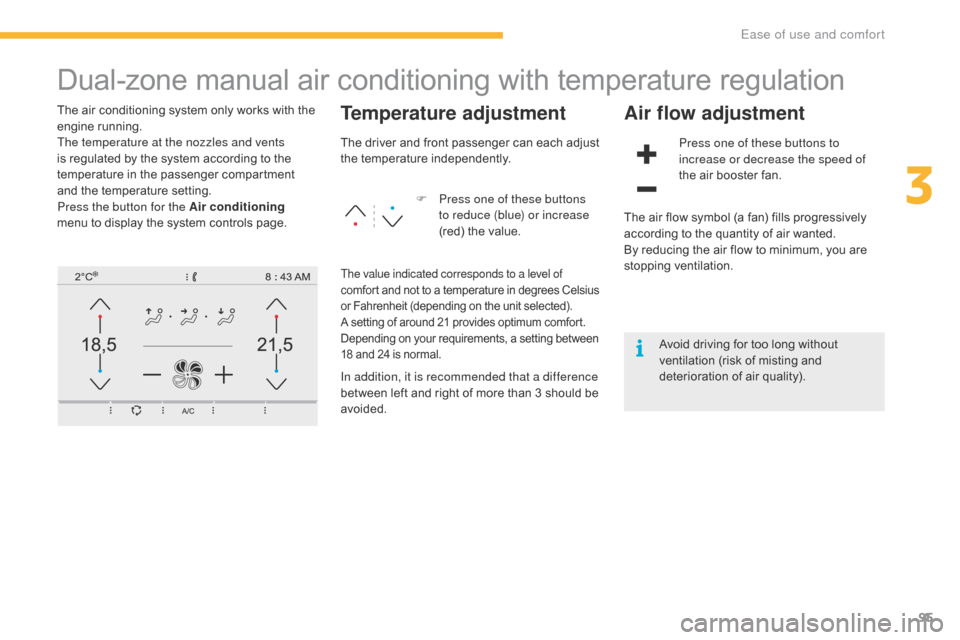
95
C4-Picasso-II_en_Chap03_ergonomie-confort_ed01-2016
Dual-zone manual air conditioning with temperature regulation
The air conditioning system only works with the engine r unning.
The temperature at the nozzles and vents
is
regulated by the system according to the
t
emperature in the passenger compartment
a
nd the temperature setting.
Press the button for the Air conditioning
menu
to display the system controls page.Temperature adjustment
F Press one of these buttons to reduce (blue) or increase
(red)
the value.
Air flow adjustment
Press one of these buttons to
increase or decrease the speed of
the air booster fan.
The
driver
and
front
passenger
can
each
adjust
t
he t
emperature i
ndependently.
The value indicated corresponds to a level of
comfort
and not to a temperature in degrees Celsius o
r Fahrenheit (depending on the unit selected).
A
setting of around 21 provides optimum comfort.
D
epending on your requirements, a setting between
1
8 and 24 is normal.
In addition, it is recommended that a difference
between left and right of more than 3 should be
av
oided. The
air flow symbol (a fan) fills progressively
a
ccording to the quantity of air wanted.
By reducing the air flow to minimum, you are
s
topping
v
entilation.
Avoid driving for too long without
v
entilation (risk of misting and d
eterioration of air quality).
3
Ease of use and comfort
Page 98 of 527
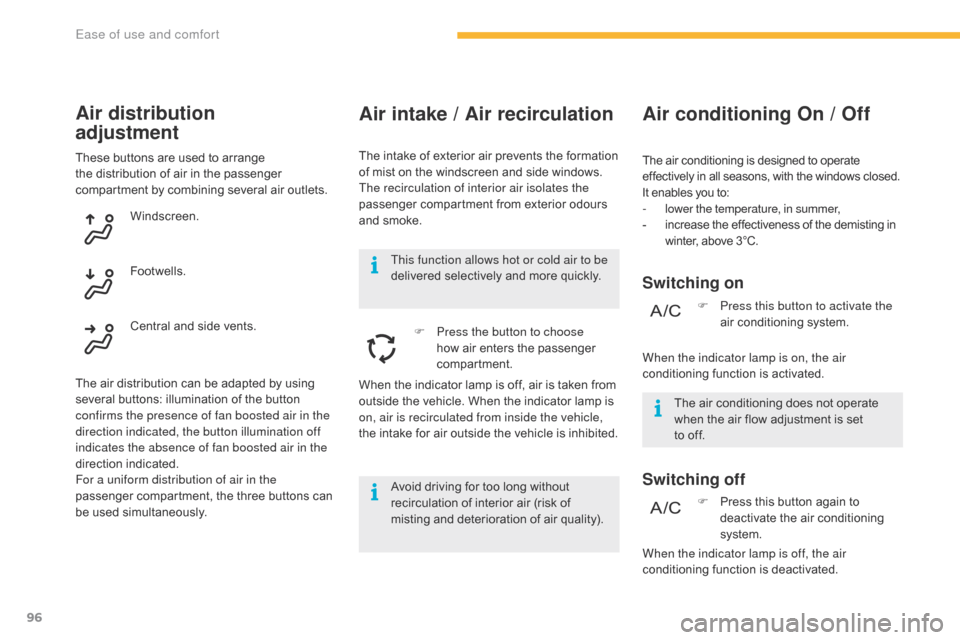
96
C4-Picasso-II_en_Chap03_ergonomie-confort_ed01-2016
Air intake / Air recirculation
The intake of exterior air prevents the formation of mist on the windscreen and side windows.
The recirculation of interior air isolates the
passenger
compartment from exterior odours
a
nd smoke.
F
P
ress the button to choose
how
air enters the passenger
c
ompartment.
Air conditioning On / Off
Switching on
Switching off
The air conditioning does not operate when the air flow adjustment is set
t
o off. F
P
ress this button to activate the
air conditioning system.
Avoid
driving
for
too
long
without
r
ecirculation
of
interior
air
(risk
of
m
isting
and
deterioration
of
air
quality).
This function allows hot or cold air to be
delivered
selectively
and
more
quickly.
The
air conditioning is designed to operate
e
ffectively in all seasons, with the windows closed.
It
enables you to:
-
l
ower the temperature, in summer,
-
i
ncrease the effectiveness of the demisting in
w
inter, above 3°C.
F
P
ress this button again to
d
eactivate the air conditioning
s
ystem.
Air distribution
adjustment
These buttons are used to arrange the distribution of air in the passenger
c
ompartment by combining several air outlets.
Windscreen.
The
air distribution can be adapted by using
s
everal buttons: illumination of the button
c
onfirms the presence of fan boosted air in the
direction indicated, the button illumination off
indicates the absence of fan boosted air in the
direction
i
ndicated.
For a uniform distribution of air in the
passenger
compartment, the three buttons can
b
e
us
ed
s
imultaneously.Footwells.
Central
and side vents.When
the indicator lamp is off, air is taken from
o
utside the vehicle. When the indicator lamp is
o
n, air is recirculated from inside the vehicle,
the
intake for air outside the vehicle is inhibited.When the indicator lamp is on, the air
conditioning
function is activated.
When the indicator lamp is off, the air
conditioning
function is deactivated.
Ease of use and comfort
Page 99 of 527
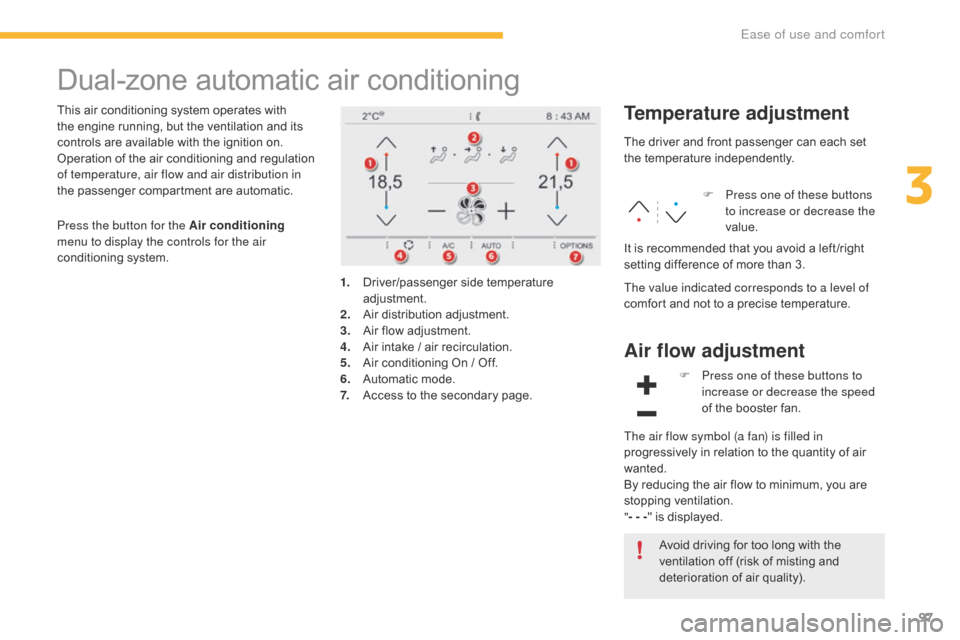
97
C4-Picasso-II_en_Chap03_ergonomie-confort_ed01-2016
Dual-zone automatic air conditioning
This air conditioning system operates with the engine running, but the ventilation and its
c
ontrols are available with the ignition on.
Operation
of the air conditioning and regulation
o
f temperature, air flow and air distribution in
the
passenger compartment are automatic.Temperature adjustment
1. Driver/passenger side t emperature adj
ustment.
2.
A
ir
d
istribution
a
djustment.
3.
A
ir flow adjustment.
4.
A
ir intake / air recirculation.
5.
A
ir conditioning On / Off.
6.
A
utomatic mode.
7.
A
ccess to the secondary page.The
driver and front passenger can each set
t
he
t
emperature
i
ndependently.
F
P
ress one of these buttons
to increase or decrease the
value.
The value indicated corresponds to a level of
comfort and not to a precise temperature.
It
is recommended that you avoid a left /right
s
etting difference of more than 3.
Press the button for the Air conditioning
menu to display the controls for the air
conditioning
system.
Air flow adjustment
Avoid driving for too long with the v
entilation off (risk of misting and
d
eterioration of air quality).
F
P
ress one of these buttons to
increase or decrease the speed
of the booster fan.
The air flow symbol (a fan) is filled in
progressively in relation to the quantity of air
w
anted.
By
reducing the air flow to minimum, you are
s
topping
v
entilation.
" - - - "
is displayed.
3
Ease of use and comfort
Page 100 of 527
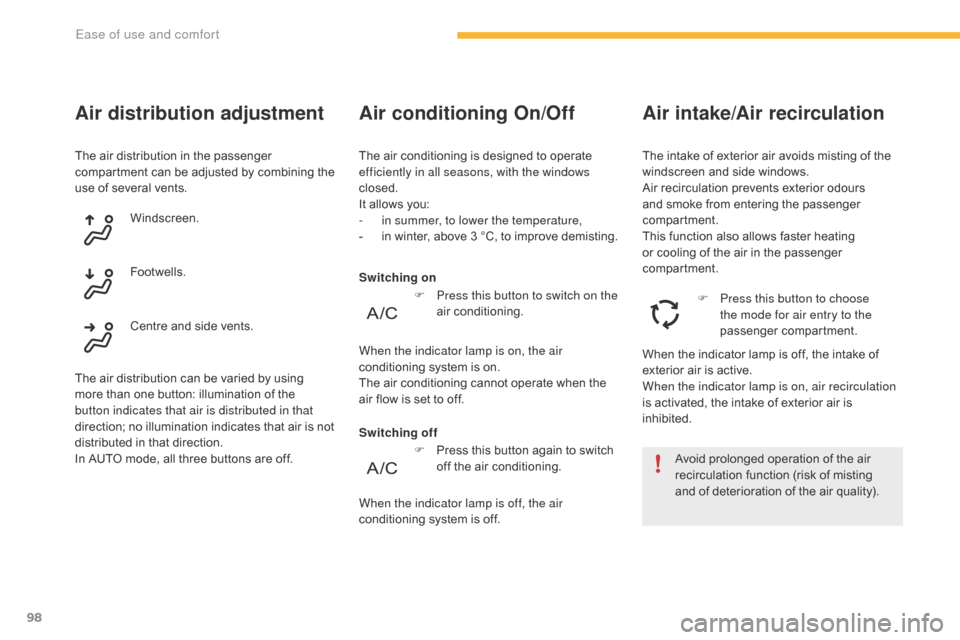
98
C4-Picasso-II_en_Chap03_ergonomie-confort_ed01-2016
The air distribution in the passenger compartment can be adjusted by combining the
u
se of several vents.
Air distribution adjustment
Windscreen.
Footwells.
Centre
and side vents.
The
air
distribution can be varied by using
m
ore
than one button: illumination of the
b
utton indicates that air is distributed in that
direction;
no illumination indicates that air is not
d
istributed in that direction.
In
AUTO
mode, all three buttons are off.Switching off Switching on
Air conditioning On/Off
The air conditioning is designed to operate e
fficiently in all seasons, with the windows
closed.
It
allows you:
-
i
n summer, to lower the temperature,
-
i
n winter, above 3 °C, to improve demisting.
Avoid
prolonged operation of the air
r
ecirculation function (risk of misting
a
nd of deterioration of the air quality).
When
the indicator lamp is off, the intake of
e
xterior air is active.
When the indicator lamp is on, air recirculation
is
activated, the intake of exterior air is
in
hibited.F
P
ress this button to choose
the mode for air entry to the
passenger
c
ompartment.
The
intake of exterior air avoids misting of the w
indscreen and side windows.
Air
recirculation prevents exterior odours
a
nd smoke from entering the passenger
c
ompartment.
This
function also allows faster heating
o
r cooling of the air in the passenger
c
ompartment.
Air intake/Air recirculation
F Press this button again to switch o
ff the air conditioning.
When the indicator lamp is off, the air
conditioning
system is off.
F
P
ress this button to switch on the
air
c
onditioning.
When the indicator lamp is on, the air
conditioning system is on.
The
air
conditioning cannot operate when the
a
ir
flow
is
set to off.
Ease of use and comfort
Page 103 of 527

101
C4-Picasso-II_en_Chap03_ergonomie-confort_ed01-2016
Settings for
passengers in
the 3
rd row of seats
F Press the vent cover.
F A djust the flow of air to the two vents using
t
he four-position wheel (off, low, medium,
hi g h).
F
D
irect the vent by turning the cover.
Ventilation with ignition on
function
With the ignition on, you can use the ventilation system and have access to the Air
conditioning
menu to adjust the air flow and
a
ir distribution in the passenger compartment.
This function is available for a few minutes,
depending
on the state of charge of the battery
o
f your vehicle.
This function does not activate the air
conditioning.
You
can make use of the residual heat in the
e
ngine to warm the passenger compartment
u
sing the temperature setting buttons.
3
Ease of use and comfort
Page 157 of 527
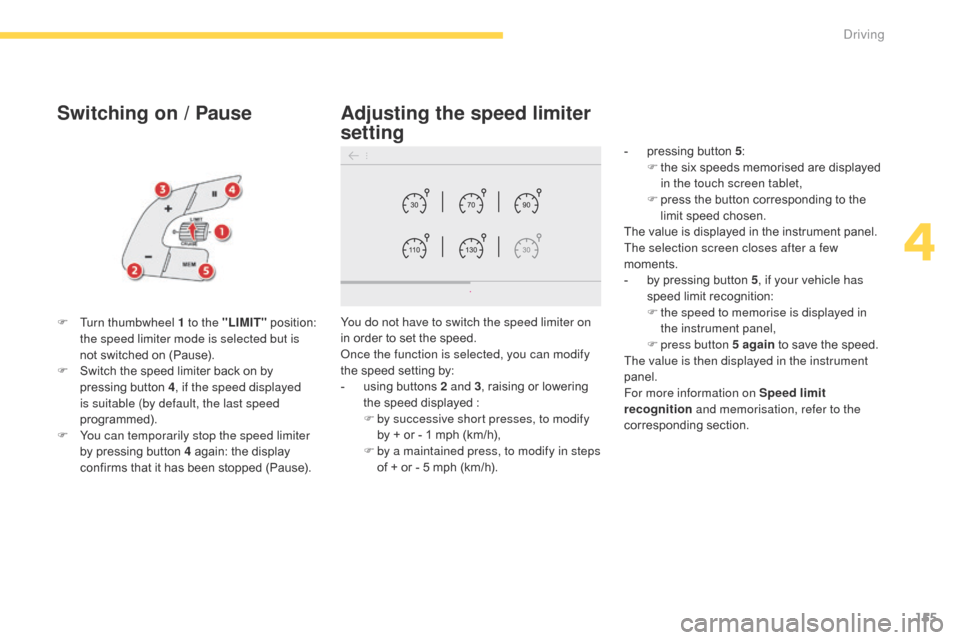
155
C4-Picasso-II_en_Chap04_conduite_ed01-2016
Switching on / Pause
F Turn thumbwheel 1 to the "LIMIT" position: t
he speed limiter mode is selected but is
not
switched on (Pause).
F
S
witch the speed limiter back on by
p
ressing button 4, if the speed displayed
is suitable (by default, the last speed
programmed).
F
Y
ou can temporarily stop the speed limiter
by
pressing button 4 again: the display
c
onfirms that it has been stopped (Pause).You do not have to switch the speed limiter on
in
order to set the speed.
Once the function is selected, you can modify
the
speed setting by:
-
u
sing buttons 2 and 3,
raising or lowering
t
he speed displayed :
F
b
y successive short presses, to modify
by
+ or - 1 mph (km/h),
F
b
y a maintained press, to modify in steps
of
+ or - 5 mph (km/h).
Adjusting the speed limiter
setting
- pressing button 5:
F t he six speeds memorised are displayed
i
n the touch screen tablet,
F
p
ress the button corresponding to the
l
imit speed chosen.
The
value is displayed in the instrument panel.
The selection screen closes after a few
moments.
-
b
y pressing button 5, if your vehicle has
speed
limit recognition:
F
t
he speed to memorise is displayed in
the instrument panel,
F
press button 5 again
to save the speed.
The value is then displayed in the instrument
panel.
For more information on Speed limit
recognition and memorisation, refer to the
corresponding
s
ection.
4
Driving
Page 160 of 527
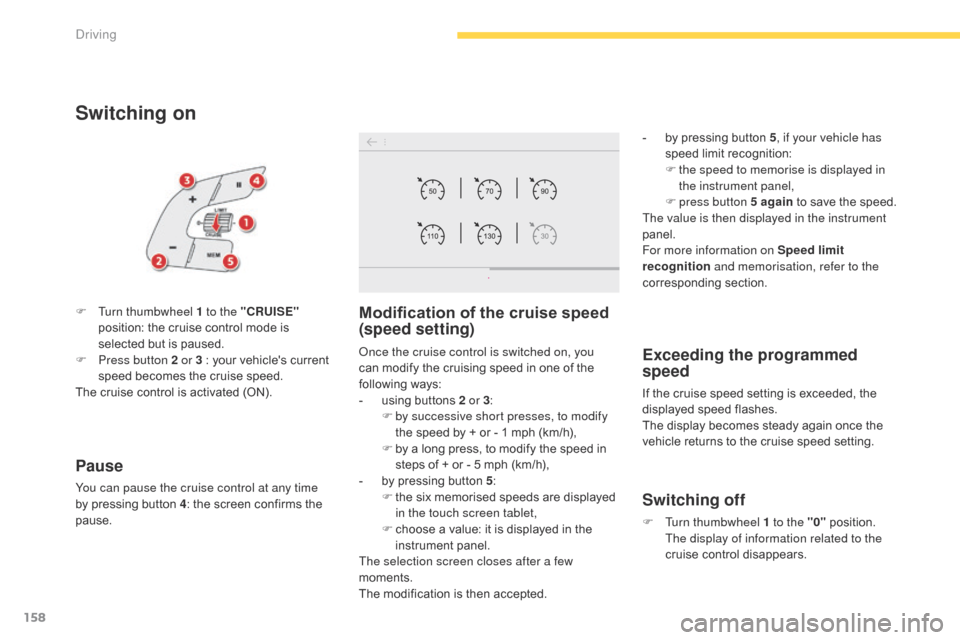
158
C4-Picasso-II_en_Chap04_conduite_ed01-2016
Exceeding the programmed
speed
If the cruise speed setting is exceeded, the displayed speed flashes.
The
display becomes steady again once the
v
ehicle returns to the cruise speed setting.
Switching off
F Turn thumbwheel 1 to the "0" p osition. T
he display of information related to the
cruise
control disappears.
Switching on
Once the cruise control is switched on, you
can modify the cruising speed in one of the
f
ollowing
w
ays:
-
u
sing buttons 2 or 3:
F
b
y successive short presses, to modify
the
speed by + or - 1 mph (km/h),
F
b
y a long press, to modify the speed in
s
teps of + or - 5 mph (km/h),
-
b
y pressing button 5:
F
t
he six memorised speeds are displayed
i
n the touch screen tablet,
F
c
hoose a value: it is displayed in the
in
strument
pan
el.
The selection screen closes after a few
moments.
The
modification is then accepted.
F
T
urn thumbwheel 1 to the "CRUISE"
position:
the
cruise
control
mode
is
s
elected
but
is
paused.
F
P
ress button 2 or 3 :
your
vehicle's
current
s
peed
becomes
the
cruise
speed.
The
cruise
control
is
activated
(ON).
Modification of the cruise speed
(speed setting)
- by pressing button 5, if your vehicle has
speed limit recognition:
F
t
he speed to memorise is displayed in
the instrument panel,
F
press button 5 again
to save the speed.
The value is then displayed in the instrument
panel.
For more information on Speed limit
recognition and memorisation, refer to the
corresponding
s
ection.
Pause
You can pause the cruise control at any time
by pressing button 4:
the screen confirms the
pa
use.
Driving
Page 161 of 527
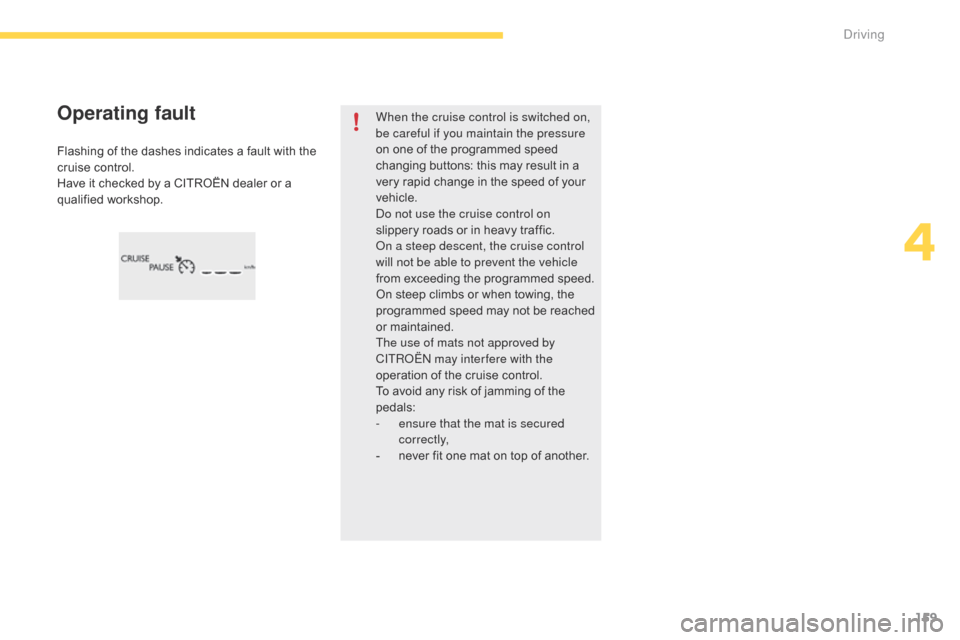
159
C4-Picasso-II_en_Chap04_conduite_ed01-2016
Flashing of the dashes indicates a fault with the cruise control.
Have
it checked by a CITROËN dealer or a
q
ualified
w
orkshop.
Operating faultWhen the cruise control is switched on,
be careful if you maintain the pressure
on one of the programmed speed
c
hanging buttons: this may result in a
v
ery rapid change in the speed of your
v
ehicle.
Do not use the cruise control on
slippery
roads or in heavy traffic.
On a steep descent, the cruise control
will not be able to prevent the vehicle
from
exceeding the programmed speed.
On
steep climbs or when towing, the
p
rogrammed speed may not be reached
o
r maintained.
The use of mats not approved by
CITROËN may inter fere with the
operation
of the cruise control.
To
avoid any risk of jamming of the
ped
als:
-
e
nsure that the mat is secured
c o r r e c t l y,
-
n
ever fit one mat on top of another.
4
Driving
Page 164 of 527
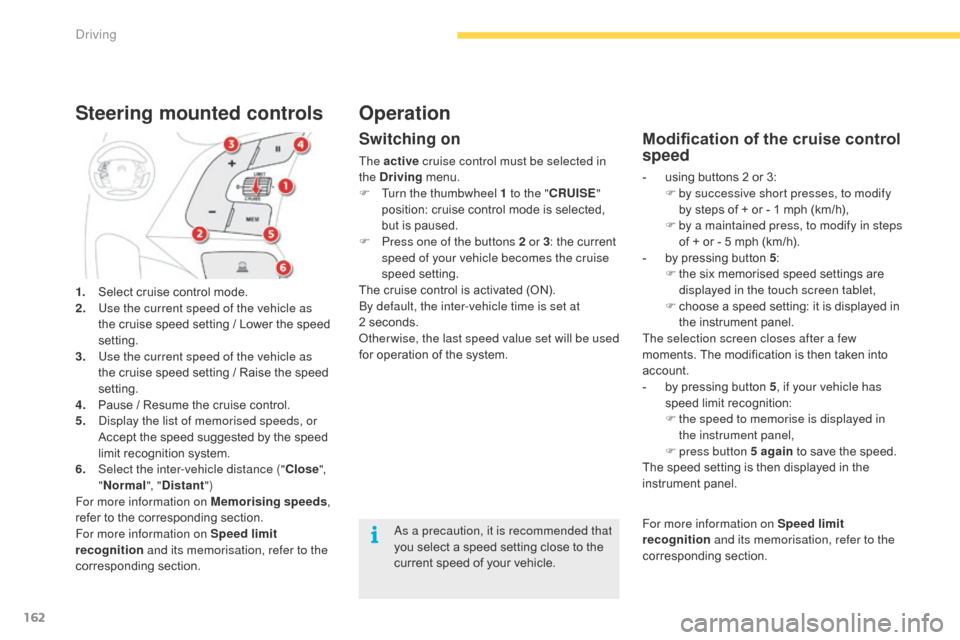
162
C4-Picasso-II_en_Chap04_conduite_ed01-2016
1. Select cruise control mode.
2. U se the current speed of the vehicle as
the
cruise speed setting / Lower the speed
se
tting.
3.
U
se the current speed of the vehicle as
the
cruise speed setting / Raise the speed
se
tting.
4.
P
ause / Resume the cruise control.
5.
D
isplay the list of memorised speeds, or
A
ccept the speed suggested by the speed
l
imit recognition system.
6.
S
elect the inter-vehicle distance (" Close",
" Normal ", "Distant ")
For more information on Memorising speeds ,
refer
to the corresponding section.
For more information on Speed limit
recognition and its memorisation, refer to the
corresponding
s
ection.
Steering mounted controls
Switching on
The active cruise control must be selected in
the Driving menu.
F
T
urn the thumbwheel 1 to the " CRUISE"
position:
cruise control mode is selected,
b
ut is paused.
F
P
ress one of the buttons 2 or 3 :
the current
s
peed of your vehicle becomes the cruise
speed
setting.
The
cruise control is activated (ON).
By default, the inter-vehicle time is set at
2 seconds.
Other wise, the last speed value set will be used
for
operation of the system.
Modification of the cruise control
speed
- using buttons 2 or 3:
F b y successive short presses, to modify
by
steps of + or - 1 mph (km/h),
F
b
y a maintained press, to modify in steps
of
+ or - 5 mph (km/h).
-
b
y pressing button 5:
F
t
he six memorised speed settings are
d
isplayed in the touch screen tablet,
F
c
hoose a speed setting: it is displayed in
t
he instrument panel.
The selection screen closes after a few
moments.
The modification is then taken into
a
ccount.
-
b
y pressing button 5, if your vehicle has
speed
limit recognition:
F
t
he speed to memorise is displayed in
the instrument panel,
F
press button 5 again
to save the speed.
The
speed setting is then displayed in the
in
strument
pan
el.
As a precaution, it is recommended that
you
select
a
speed
setting
close
to
the
c
urrent
speed
of
your
vehicle.
Operation
For more information on Speed limit
recognition and its memorisation, refer to the
corresponding
s
ection.
Driving
Page 168 of 527
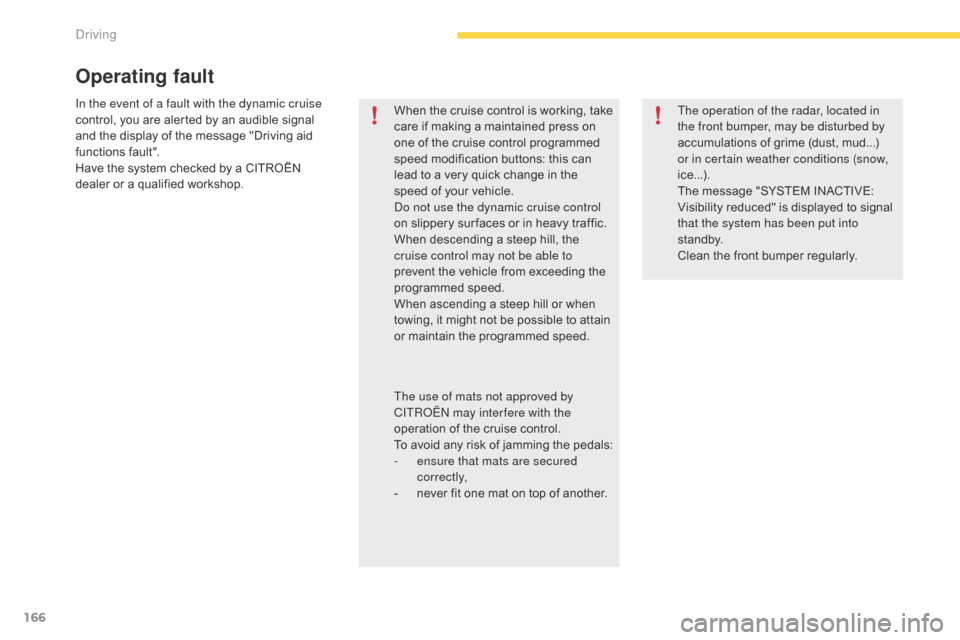
166
C4-Picasso-II_en_Chap04_conduite_ed01-2016
In the event of a fault with the dynamic cruise
control, you are alerted by an audible signal
a
nd the display of the message "Driving aid
f
unctions
f
ault".
Have
the system checked by a CITROËN
d
ealer or a qualified workshop. When
the cruise control is working, take
c
are if making a maintained press on
o
ne of the cruise control programmed
s
peed modification buttons: this can
l
ead to a very quick change in the
s
peed of your vehicle.
Do not use the dynamic cruise control
on
slippery sur faces or in heavy traffic.
When
descending a steep hill, the
c
ruise control may not be able to
prevent
the vehicle from exceeding the
pro
grammed
s
peed.
When
ascending a steep hill or when
t
owing, it might not be possible to attain
o
r maintain the programmed speed.
Operating fault
The operation of the radar, located in
the front bumper, may be disturbed by
accumulations of grime (dust, mud...)
o
r in certain weather conditions (snow,
ice...).
The
message "SYSTEM INACTIVE:
V
isibility reduced" is displayed to signal
t
hat the system has been put into
st a n dby.
Clean
the front bumper regularly.
The use of mats not approved by
CITROËN may inter fere with the
operation
of
the
cruise
control.
To
avoid
any
risk
of
jamming
the
pedals:
-
e
nsure that mats are secured
c o r r e c t l y,
-
n
ever
fit
one
mat
on
top
of
another.
Driving